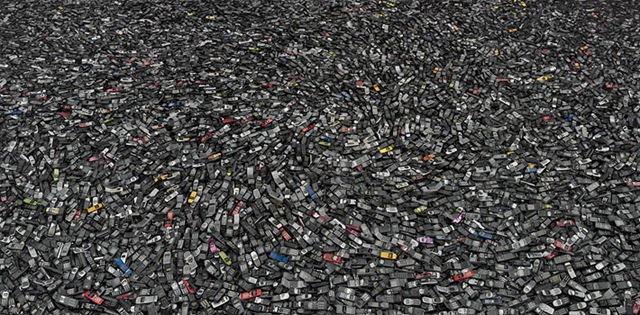I’ve recently heard a statistic that’s just plain scary. I was told that most cell phone recyclers operate on a 2-3 year backlog. I don’t know if that’s true. Think about it, if that’s true then nearly every phone made in the last five years, and every phone you’ve gotten rid of recently, is still there, somewhere. My paranoia doesn’t lift when I see photos like this one:

According to this site these are all phones waiting for recycling. What’s even scarier is that the photo is ten years old. Things probably haven’t gotten better wherever that pic was snapped.
It turns out that recycling a phone might actually be harder than making one. Making a phone involves taking a bunch of different pieces and combining them. It’s done with a combination of robots and very patient people. Taking apart a phone is 100% manual labor. Every model of phone is different and every phone may have different challenges.
Most of us merrily change phones about once a year now. A lot of those phones are perfectly good and end up on the secondary market. They’ll eventually end up in the recycle bin and it’s pretty sad to think they’ll spend more time waiting to be recycled than they spent being used.
Plastic, sand, metal, and poison
Those are essentially the four components of a cell phone. Silicon, the heart of most computer chips, is a key component of sand. There’s a ton of plastic in today’s phones too, from the cases to the boards inside to the little bag that holds the battery together. The other two bits aren’t terribly surprising either — it makes sense for something electrical to have a lot of metal. But, it’s the last piece that’s really problematic.
If it weren’t for the poison, recycling would probably be pretty easy. Let’s see. Heat the thing up until the plastic melts and you have nothing but base metal and silicon. Both of these are completely benign to the environment. If they’re not worth the money to recycle it’s not a problem. When you add lead, mercury, gallium, cadmium, lithium, and other substances to the mix you have a problem. You can’t put any of this stuff back into nature legally, not in this country anyway. It gets into the air, it gets into the workers’ bodies, and all of a sudden you begin to understand why cell phone recycling is such a touchy business.
It’s not getting better
If you look at the trends from companies like iFixit, cell phones are getting harder to dismantle not easier. It’s our own faults- we want slender and powerful phones so that makes it harder to use screws and clips in our phones. More and more companies are relying on more and more glue as well as shoving more and more components into weird corners and pockets of the devices. Every millimeter counts on a phone and that makes it harder to have different components come apart cleanly.
A cell phone from the 2000s wasn’t the easiest thing to dismantle but generally you could separate the body from the circuit board and easily dispose of the battery. That’s certainly not true now.
Repairability bills?
States and countries are starting to push for laws that would guarantee that phones are more repairable and therefore easier to dismantle. The downside of course would be that the phones themselves wouldn’t be as sleek, and people wouldn’t want them.
I’m not sure if a law is the answer here. Truth is I don’t know what the answer is. I only know that if what I heard is true then there’s a real problem and it isn’t getting any easier to deal with. The cost of recycling is bound to go up, but the cost of not recycling is just something we can’t live with.





